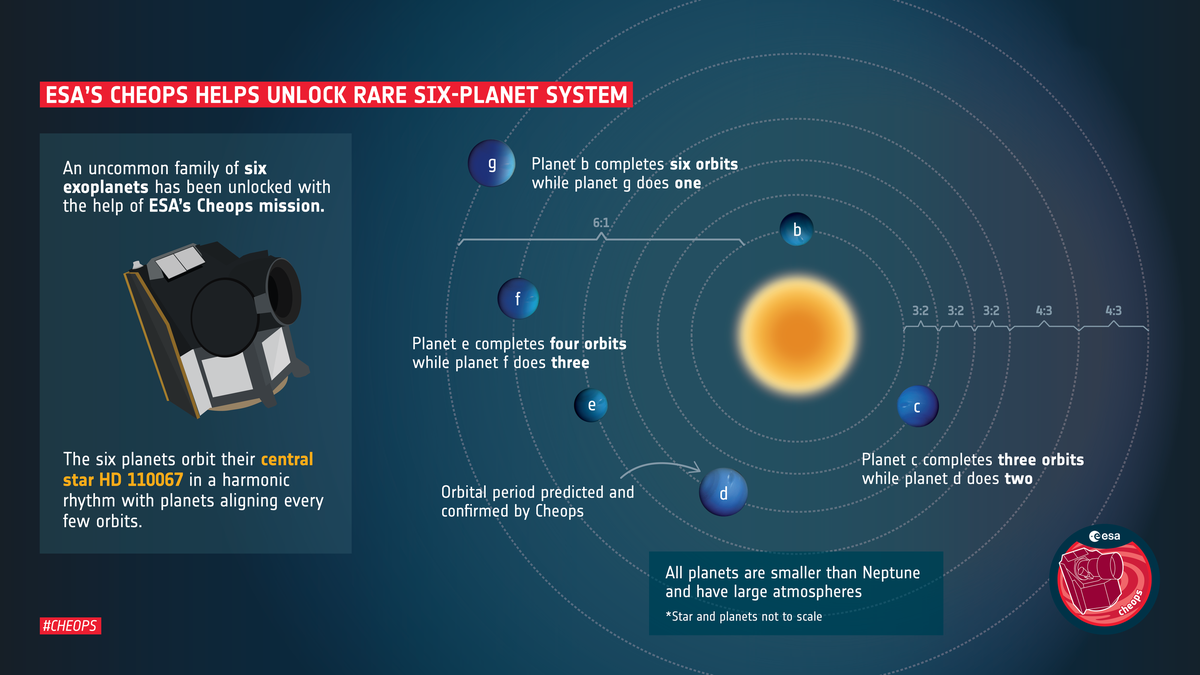Important Facts For Prelims
Six Exoplanets Found Orbiting Around HD 110067
- 08 Dec 2023
- 4 min read
Why in News?
A recent study published in Nature has unveiled the discovery of six exoplanets orbiting a nearby bright star, HD 110067, located in the Coma Berenices constellation.
- These planets referred to as ‘sub-Neptunes’, were detected and characterized by using data from two space telescopes: National Aeronautics and Space Administration's (NASA) Transiting Exoplanet Survey Satellite (TESS) and European Space Agency’s(ESA) CHaracterising ExOPlanet Satellite (CHEOPS).
Note
- CHEOPS is ESA's first space mission dedicated to studying bright, nearby stars that are already known to host exoplanets, in order to make high-precision observations of the planet's size as it passes in front of its host star.
What are the Key Facts about Sub-Neptunes?
- The six exoplanets in the HD 110067 system are classified as 'sub-Neptunes.’
- Planets with radii between that of the Earth and Neptune are referred to as ‘sub-Neptunes’.
- Calculations of their masses and densities indicate the presence of relatively low-density atmospheres, potentially rich in hydrogen.
- All six planets are in resonant orbits, in which the planets exert regular forces on each other as they orbit.
- This feature suggests that the system remains practically unchanged since its birth, at least four billion years ago.
- The planets are named HD 110067 b, c, d, e, f, and g, in order of increasing distance from the star.
HD 110067
- The star is called HD 110067, and it is located about 100 light-years away from Earth, located in the Coma Berenices constellation.
- It is visible from the Northern Hemisphere, and it is the brightest star found to host more than four transiting exoplanets to date.
- The Coma Berenices constellation, also known as Berenice's Hair, is a medium-sized constellation in the northern celestial hemisphere. It's visible in both hemispheres, but is most easily seen in the northern hemisphere during spring and summer.
What is an Exoplanet?
- Exoplanets are planets that orbit other stars and are beyond our solar system.
- The first confirmation of detection of exoplanets occurred in 1992.
- According to NASA, to date, more than 5,000 exoplanets have been discovered.
UPSC Civil Services Examination, Previous Year Question (PYQ)
Prelims
Q. The term ‘Goldilocks Zone’ is often seen in the news in the context of (2015)
(a) the limits of habitable zone above the surface of the Earth
(b) regions inside the Earth where shale gas is available
(c) search for the Earth-like planets in outer space
(d) search for meteorites containing precious metals
Ans: (c)
Exp:
- The ‘Goldilocks Zone’ refers to the habitable zone around a star where the temperature is just right – not too hot and not too cold – for liquid water to exist on a planet.
- Since liquid water is essential for life as it has potential to accommodate biotic organism, thereby, it is called ‘habitable zone’.
- Therefore, option (c) is the correct answer.








